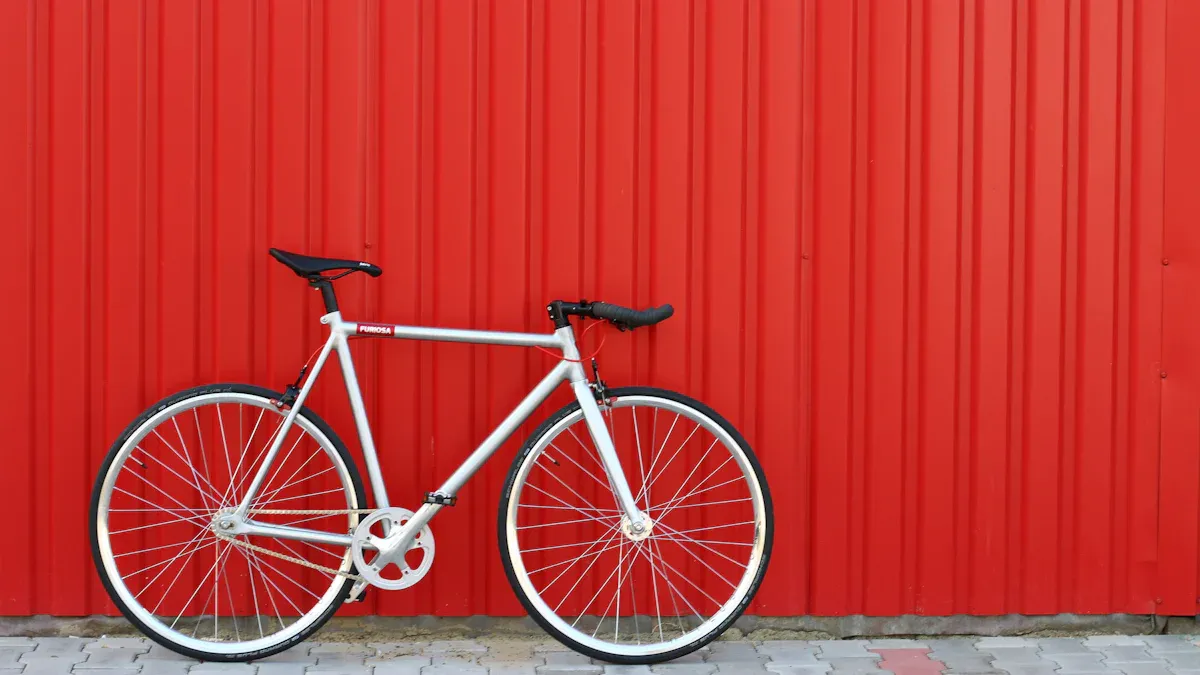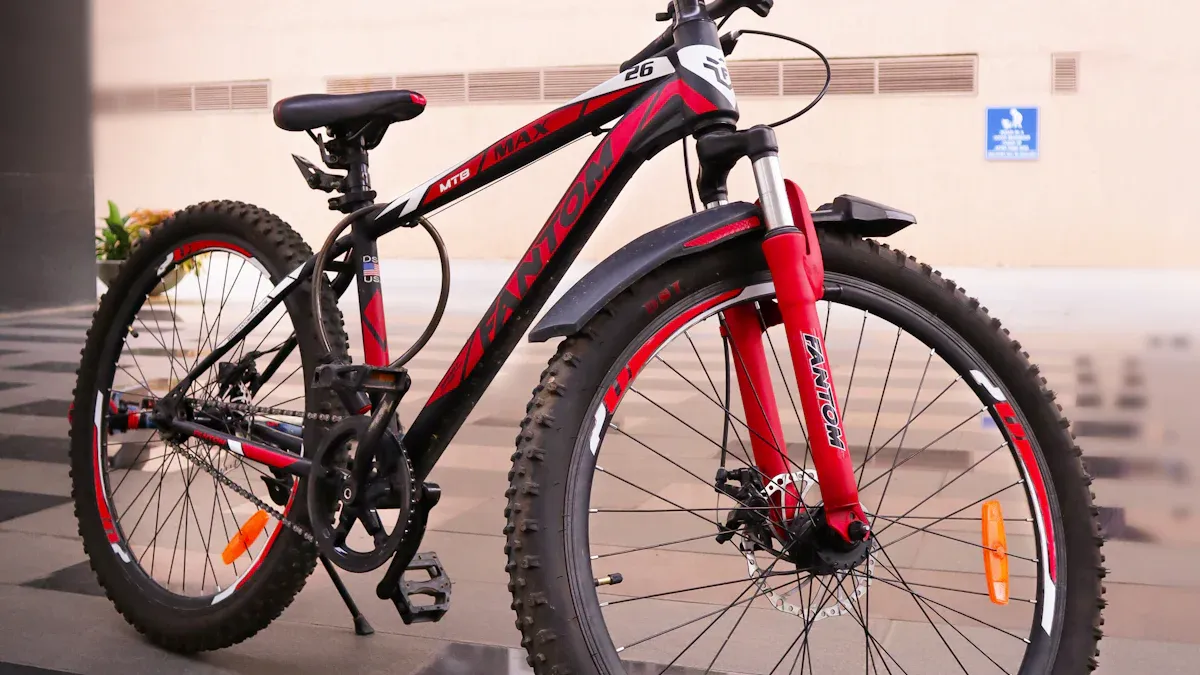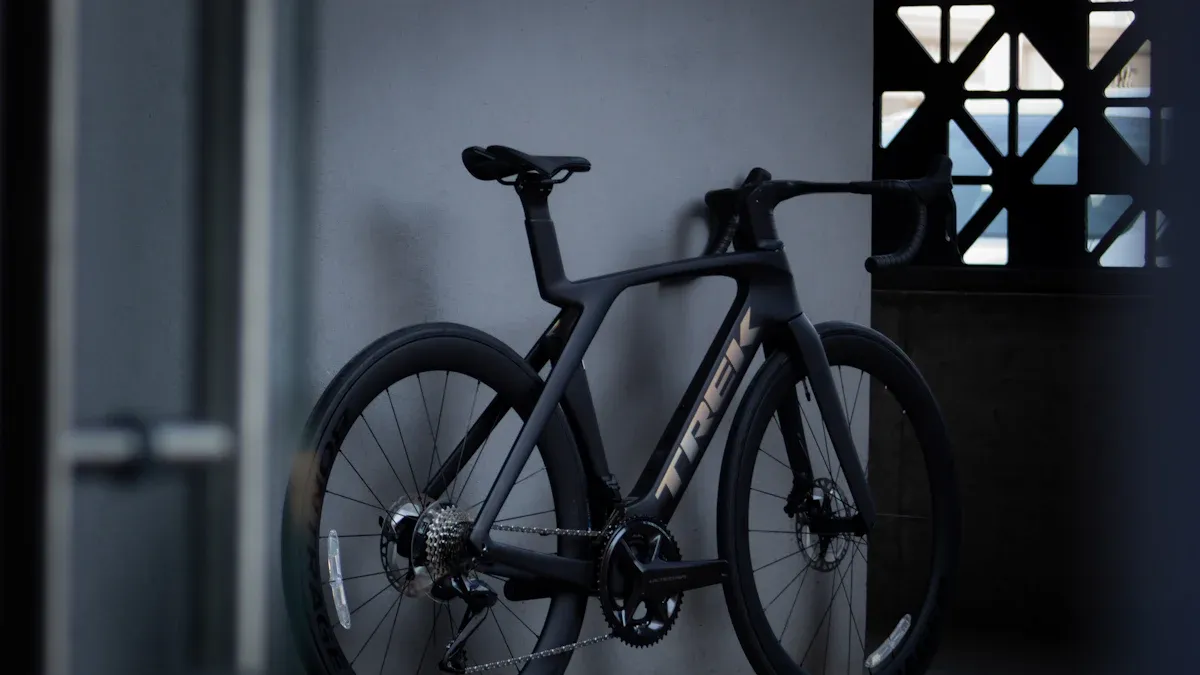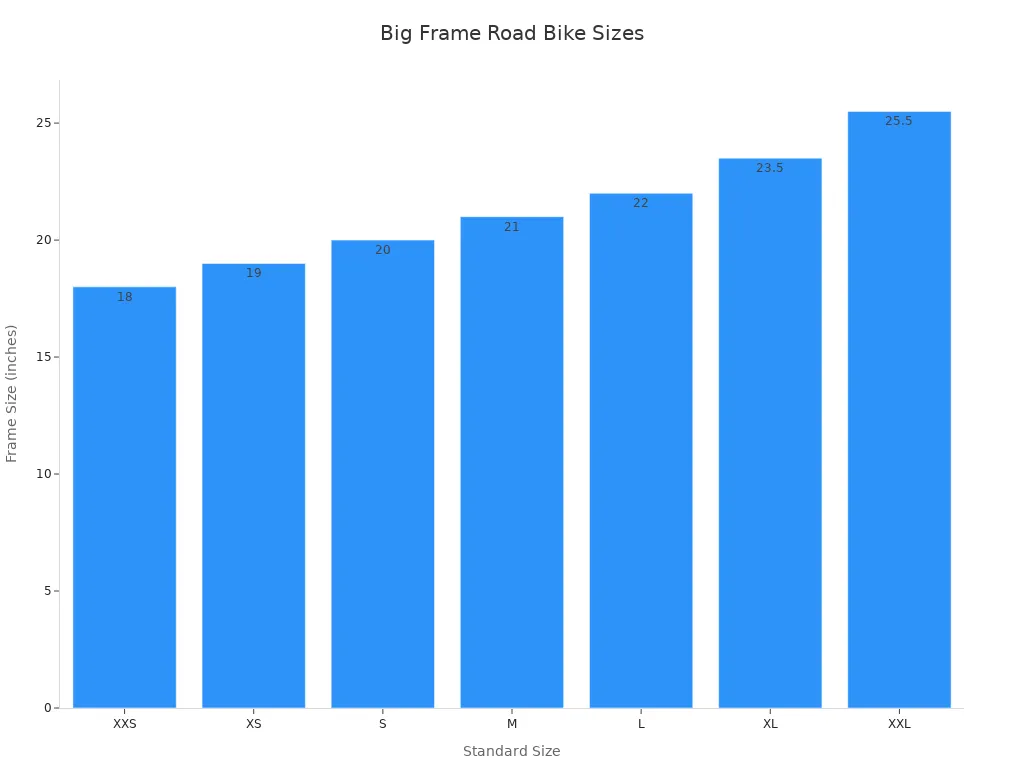
Choosing the right bike frame size is very important. It affects your comfort and how well you ride. If you have a big frame road bike, getting this size right matters a lot. A bike that fits well makes riding more enjoyable. It also helps stop discomfort and injuries. So, take time to measure carefully. Make sure your bike feels perfect for you!
Key Takeaways
Measure your height and inseam carefully. These measurements are very important for finding the right bike frame size.
A bike that fits well makes riding more comfortable and better. It lowers the chance of injuries and lets you ride longer and have fun.
Think about standard frame sizes or custom choices. Pick what feels best for you and how you ride.
Try out different bikes. This helps you see how comfortable they are and if they fit before you buy.
Make changes after you buy. Adjusting the saddle height and handlebar position can really make your ride better.
Frame Size Basics

When it comes to riding a big frame road bike, the right bike frame size plays a crucial role in your comfort and performance. A well-fitted bike allows you to ride longer distances with less fatigue. You want to feel at ease while pedaling, and the right frame size helps achieve that. If your bike frame is too small or too large, you might experience discomfort, which can lead to poor riding posture and even injuries.
Here’s why frame size matters:
Comfort: A bike that fits you well reduces strain on your body. For taller riders, a larger frame can help maintain a natural riding position. This means less pressure on your back and neck, allowing you to enjoy your ride without discomfort.
Performance: The right bike frame size enhances your efficiency. When your bike fits you properly, you can generate more power with each pedal stroke. This is especially important for long rides where endurance is key. A taller headtube, for example, brings the handlebars closer, making it easier to maintain a comfortable position during extended rides.
Adjustments to your bike’s components, like saddle height and handlebar position, also depend on your frame size. If your frame is too small, you might find yourself stretching too much, which can lead to discomfort. On the other hand, a frame that’s too large can make it hard to control your bike effectively.
Remember, a well-fitted bike not only improves your comfort but also boosts your performance. So, take the time to find the right bike frame size. It’s worth it for those long rides ahead!
Measuring for Your Bike Sizing Guide

Getting the right measurements is key to finding your perfect bike size. Let’s break down how to measure your height and inseam accurately. These measurements will help you select the right frame size for your big frame road bike.
Height Measurement
To measure your height correctly, follow these simple steps:
Stand upright against a wall with your shoes off.
Look straight ahead and keep your shoulders back.
Mark the wall above your head with a pencil, holding it flat and parallel to the floor.
Measure the height from the floor to the mark using a tape measure.
This measurement gives you a good starting point for determining your bike size. Taller riders often face challenges when selecting a bike, so knowing your height accurately is crucial.
Inseam Measurement
Your inseam measurement is just as important as your height. It helps ensure that you have the right stand over height and can ride comfortably. Here’s how to measure your inseam:
Stand with your back against a wall and hold a book between your legs.
Make sure the book’s spine meets your crotch.
Mark where the spine hits the wall or have a friend measure from the top of the book to the floor.
Accurate inseam measurement is essential for determining the right frame size for big frame road bikes. It enhances comfort, control, and efficiency while riding. Combining your inseam with your overall height helps fine-tune the frame size you need.
Many riders make common mistakes during bike sizing measurements. For instance, they might change equipment without adjusting their fit or assume that a bike fit will resolve all physical discomforts. Remember, it’s important to consider your riding technique and how it affects your fit.
By taking the time to measure your height and inseam accurately, you set yourself up for a more enjoyable riding experience. A well-fitted bike not only improves comfort but also boosts your performance on the road.
Choosing a Big Frame Road Bike
When you’re on the hunt for a big frame road bike, understanding your options is crucial. You want a bike that not only fits you well but also enhances your riding experience. Let’s dive into the two main choices: standard frame sizes and custom frame options.
Standard Frame Sizes
Most bike manufacturers offer standard frame sizes that cater to a range of heights and inseam measurements. These sizes help you quickly identify the right bike frame size for your needs. Here’s a handy table that outlines the standard frame sizes available for big frame road bikes:
Inseam (inches) | Height (feet) | Frame Size (inches) | Standard Size |
|---|---|---|---|
25.0 – 26.4 | 4′ 7″ – 4′ 11″ | 18″ | XXS |
26.4 – 27.9 | 4′ 8″ – 5′ 1″ | 19″ | XS |
27.9 – 29.3 | 5′ 0″ – 5′ 5″ | 20″ | S |
29.3 – 30.7 | 5′ 3″ – 5′ 8″ | 21″ | M |
30.7 – 32.2 | 5′ 6″ – 6′ 0″ | 22″ | L |
32.2 – 33.6 | 5′ 10″ – 6′ 2″ | 23″ | XL |
33.6 – 35.0 | 6′ 0″ – 6′ 5″ | 24″ | XL |
35.0 – 36.4 | 6′ 3″ – 6′ 8″ | 25″ | XXL |
37.2+ | 6′ 6″+ | 26″ | XXL |

These sizes are based on the inseam measurement, which is crucial for determining your stand over height. A correctly sized bike allows you to ride comfortably and efficiently. If you find yourself between sizes, consider your riding style. For instance, if you prefer a more aggressive position, you might opt for a smaller frame. On the other hand, if comfort is your priority, a larger frame could be the way to go.
Custom Frame Options
If standard sizes don’t quite fit your needs, custom frame options might be the solution. Custom frames offer several advantages, especially for taller cyclists who often struggle with poor bike fit. Here are some benefits of choosing a custom frame:
Perfect Fit: Custom frames ensure comfort and better power transmission. They address specific issues like back discomfort that many taller riders face.
Personalization: You can customize the geometry, components, and aesthetics to match your preferences. This means you can create a bike that feels just right for you.
High-Quality Craftsmanship: Many custom frames are handcrafted by skilled artisans. This often results in unmatched quality compared to mass-produced bikes.
Unique Aesthetic: Custom finishes and paint jobs allow you to express your personal style, making your bike truly one-of-a-kind.
However, keep in mind that custom frames can be significantly more expensive than standard models. Prices for custom frame road bikes can start at around $1,799 and go up to $2,799, while comparable big brand models range from $2,599 to $3,299. Despite the higher cost, the benefits of improved comfort and fit can make it worth the investment.
Understanding Size Charts
When you start looking for a big frame road bike, knowing size charts is very important. Different brands have their own sizing systems. Learning how to compare them can save you time and frustration. Let’s look at how to compare size charts from different brands and what to notice when reading them.
Comparing Brands
Each bike maker has its own way of sizing. Here are some key points to remember when comparing size charts:
Height vs. Proportions: Most brands base their size charts on total rider height. But your body shape, like torso and leg length, can change the best size for you.
Rider Feedback: Brands often listen to feedback from riders of different heights when making new models. This can cause differences in size options, so don’t be surprised if one brand’s large feels different from another’s.
Measurement Units: Road bike sizes are usually shown in centimeters. The seat tube measurement is a key sign of frame size. Make sure you’re okay with metric measurements, especially if you usually use imperial units.
Interpreting Size Charts
Reading size charts can be hard, especially with the differences between brands. Here are some common problems you might face:
Sizing Variability: Different sizing systems can cause confusion. For example, one brand might call a size “large,” while another uses numbers. This can mislead you.
Accurate Measurements: Getting your height and inseam measurements right is very important for picking the right bike size. If you skip this step, you might get a bike that doesn’t fit well.
Test Rides: Many riders forget how important test rides are. Even if a size chart suggests a certain frame size, nothing beats how a bike feels when you ride it.
Tip: Always check if the brand has a size guide on their website. This can help you see how their sizes compare to others.
As you look through the different bike size charts, remember that sizing can change between makers. This shows how important it is to think about your personal preferences and body shape in the fitting process. You might even find that sizing up or down based on your riding style makes a difference. For example, some pros like smaller frames for a more aggressive riding position.
By taking the time to compare size charts and read them correctly, you’ll be better ready to find a big frame road bike that fits you just right.
Adjustments for Comfort
Finding the right bike size is just the start. After you get your big frame road bike, making comfort adjustments is very important. Two main areas to focus on are saddle position and handlebar height. These changes can really improve your riding experience.
Saddle Position
Getting your saddle position right can change everything. Here are some tips to help you adjust it well:
Seat Height: Set your saddle to the height of your hip bone. When you sit on the saddle, you should touch the pedal with your heel at the bottom. This setup lets your knee bend slightly, which is important for comfort and power.
Saddle Tilt: Keep the saddle flat to the ground. Don’t tilt the nose down, as this can cause sliding and strain. A level position helps keep you comfortable on long rides.
Fore-and-Aft Position: Move the saddle forward or back to find the right weight balance. This change affects your comfort and balance while riding.
Research shows that adjusting your saddle can greatly affect comfort and performance for tall riders. In fact, “In our research with nearly 200 cyclists, 78% performed better with slight saddle adjustments between different riding disciplines.” So, don’t be afraid to adjust your saddle based on how you ride.
Handlebar Height
Handlebar height is also very important for comfort. Here’s how to adjust it:
General Recommendation: Line up the handlebars with the saddle for a comfy, upright position. This setup works well for most riders.
Aggressive Riding Posture: If you like a more aggressive position, you can lower the handlebars a bit. This change can help with aerodynamics but may need more core strength.
Incremental Changes: Make small adjustments and check your comfort after each one. If you feel neck pain, shoulder tension, or hand numbness, it might be time to change your handlebar height.
The right handlebar height helps keep your wrists neutral, reducing strain on your back and neck. If your handlebars are too low, you might hunch over, causing discomfort on long rides.
By taking time to adjust your saddle and handlebars, you can have a better riding experience. Remember, comfort is key to enjoying those long rides on your big frame road bike!
Test Riding Your Bike
When it comes to finding the right bike size, nothing beats a test ride. You can read all the size charts and measurements, but actually riding the bike gives you a real feel for how it fits. A test ride helps you evaluate your comfort and fit, ensuring that you’re making the right choice for your big frame road bike.
Importance of a Test Ride
Test rides are essential for several reasons:
Evaluate Comfort: You can assess how the bike feels under you. Is the saddle comfortable? Do you feel cramped or stretched out?
Adjustments: You can make quick adjustments to saddle height and handlebar position. This helps determine if the cockpit length suits you.
Verify Fit: A proper fit is crucial, regardless of the frame size. You can check this by measuring saddle height and cockpit length during your ride.
Taking the time to test ride ensures that you won’t face discomfort on long rides.
What to Look For
During your test ride, keep an eye on these key factors:
Saddle Position: Make sure your knee aligns over the pedal axle when the crank is at the front-most part of its circle. This alignment is crucial to avoid knee strain. Also, check that the saddle width supports your sit bones for comfort.
Body Position: Pay attention to how your body feels. Are you comfortable? Do you feel in control?
Terrain Testing: If possible, take the bike through various terrains or conditions you plan to ride in regularly. This will give you a better idea of how it performs in real-world situations.
Here’s a quick checklist to help you during your test ride:
Stand in socks on a hard, flat surface with your feet about 6-8 inches apart.
Place a book or ruler between your legs, pressing it firmly against your crotch.
Ensure the book or ruler is level with the ground, and measure the distance from the top of the book or ruler to the floor.
By focusing on these aspects, you can make an informed decision about the right bike size for you. Remember, a test ride is your chance to ensure that your new bike will be a joy to ride!
Choosing the right frame size for your big frame road bike is very important for a comfy and fun ride. Keep these main points in mind:
Accurate Measurements: Make sure to measure your height and inseam carefully. These are key to finding the right fit.
Comfort Matters: A bike that fits well lowers the chance of injuries and boosts your performance. Getting the right size means better fit, comfort, and efficiency on long rides.
Here’s a quick look at the long-term benefits of picking the right bike size:
Evidence | Explanation |
|---|---|
A bike that fits well makes long rides more comfortable, which is important for enjoying cycling over time. | |
Comfort reduces injury risk | A bike that fits right lessens strain on your body, helping to avoid injuries as you ride. |
Performance improvement | The right size can improve your cycling performance, making rides more efficient and fun. |
Take your time when choosing your bike frame. Talk to knowledgeable bike salespeople and think about your riding style. A little patience now can lead to many enjoyable rides later! 🚴♂️
FAQ
How do I know the right size of bikes for me?
To find the right size of bikes, measure your height and inseam. Use these measurements to consult size charts from different brands. A test ride can also help you determine the best fit.
What if I’m between two bike sizes?
If you’re between sizes, consider your riding style. If you prefer comfort, choose the larger size. For a more aggressive riding position, opt for the smaller size. Test riding both can help you decide.
Can I adjust my bike after buying it?
Absolutely! You can adjust the saddle height and handlebar position to enhance comfort. Small tweaks can make a big difference in your riding experience, so don’t hesitate to make changes.
How does the size of a child’s bike differ from adult bikes?
The size of a child’s bike is smaller and designed for shorter riders. It’s important to choose a bike that allows your child to reach the ground comfortably. This ensures safety and confidence while riding.
Why is frame size important for taller cyclists?
Frame size is crucial for taller cyclists because it affects comfort and performance. A properly sized bike helps maintain a natural riding position, reducing strain on your back and neck during long rides.
See Also
Selecting The Perfect Bike Frame For Your Requirements
Understanding Large Mountain Bike Frame Sizes And Geometry
The Importance Of Road Bike Frame Size For Comfort
